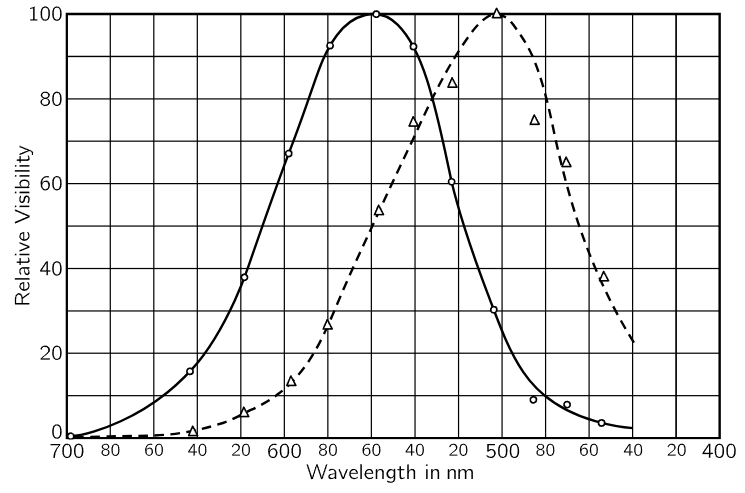


 الفيزياء الكلاسيكية
الفيزياء الكلاسيكية
 الكهربائية والمغناطيسية
الكهربائية والمغناطيسية
 علم البصريات
علم البصريات
 الفيزياء الحديثة
الفيزياء الحديثة
 النظرية النسبية
النظرية النسبية
 الفيزياء النووية
الفيزياء النووية
 فيزياء الحالة الصلبة
فيزياء الحالة الصلبة
 الليزر
الليزر
 علم الفلك
علم الفلك
 المجموعة الشمسية
المجموعة الشمسية
 الطاقة البديلة
الطاقة البديلة
 الفيزياء والعلوم الأخرى
الفيزياء والعلوم الأخرى
 مواضيع عامة في الفيزياء
مواضيع عامة في الفيزياء|
أقرأ أيضاً
التاريخ: 4-1-2021
التاريخ: 21-3-2016
التاريخ: 2024-03-24
التاريخ: 11-1-2016
|
One of the most striking phenomena of vision is the dark adaptation of the eye. If we go into the dark from a brightly lighted room, we cannot see very well for a while, but gradually things become more and more apparent, and eventually we can see something where we could see nothing before. If the intensity of the light is very low, the things that we see have no color. It is known that this dark-adapted vision is almost entirely due to the rods, while the vision in bright light is due to the cones. As a result, there are a number of phenomena that we can easily appreciate because of this transfer of function from the cones and rods together, to just the rods.
There are many situations in which, if the light intensity were stronger, we could see color, and we would find these things quite beautiful. One example is that through a telescope we nearly always see “black and white” images of faint nebulae, but W. C. Miller of the Mt. Wilson and Palomar Observatories had the patience to make color pictures of some of these objects. Nobody has ever really seen these colors with the eye, but they are not artificial colors, it is merely that the light intensity is not strong enough for the cones in our eye to see them. Among the more spectacular such objects are the ring nebula and the Crab nebula. The former shows a beautiful blue inner part, with a bright red outer halo, and the latter shows a general bluish haze permeated by bright red-orange filaments.
In the bright light, apparently, the rods are at very low sensitivity but, in the dark, as time goes on they pick up their ability to see light. The variations in light intensity for which one can adapt is over a million to one. Nature does not do all this with just one kind of cell, but she passes her job from bright-light-seeing cells, the color-seeing cells, the cones, to low-intensity, dark-adapted cells, the rods. Among the interesting consequences of this shift is, first, that there is no color, and second, that there is a difference in the relative brightness of differently colored objects. It turns out that the rods see better toward the blue than the cones do, and the cones can see, for example, deep red light, while the rods find that absolutely impossible to see. So red light is black so far as the rods are concerned. Thus, two pieces of colored paper, say blue and red, in which the red might be even brighter than the blue in good light, will, in the dark, appear completely reversed. It is a very striking effect. If we are in the dark and can find a magazine or something that has colors and, before we know for sure what the colors are, we judge the lighter and darker areas, and if we then carry the magazine into the light, we may see this very remarkable shift between which was the brightest color and which was not. The phenomenon is called the Purkinje effect.

Fig. 35–3. The spectral sensitivity of the eye. Dashed curve, rods; solid curve, cones.
In Fig. 35–3, the dashed curve represents the sensitivity of the eye in the dark, i.e., using the rods, while the solid curve represents it in the light. We see that the peak sensitivity of the rods is in the green region and that of the cones is more in the yellow region. If there is a red-colored page (red is about 650 mμ) we can see it if it is brightly lighted, but in the dark it is almost invisible.
Another effect of the fact that rods take over in the dark, and that there are no rods in the fovea, is that when we look straight at something in the dark, our vision is not quite as acute as when we look to one side. A faint star or nebula can sometimes be seen better by looking a little to one side than directly at it, because we do not have sensitive rods in the middle of the fovea.
Another interesting effect of the fact that the number of cones decreases as we go farther to the side of the field of view is that even in a bright light color disappears as the object goes far to one side. The way to test that is to look in some particular fixed direction, let a friend walk in from one side with colored cards, and try to decide what color they are before they are right in front of you. One finds that he can see that the cards are there long before he can determine the color. When doing this, it is advisable to come in from the side opposite the blind spot, because it is otherwise rather confusing to almost see the color, then not see anything, then to see the color again.
Another interesting phenomenon is that the periphery of the retina is very sensitive to motion. Although we cannot see very well from the corner of our eye, if a little bug moves and we do not expect anything to be moving over there, we are immediately sensitive to it. We are all “wired up” to look for something jiggling to the side of the field.



|
|
|
|
دراسة تحدد أفضل 4 وجبات صحية.. وأخطرها
|
|
|
|
|
|
|
جامعة الكفيل تحتفي بذكرى ولادة الإمام محمد الجواد (عليه السلام)
|
|
|